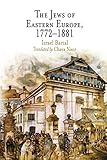The Jews of Eastern Europe, 1772-1881 / Israel Bartal.
Material type: TextSeries: Jewish Culture and ContextsPublisher: Philadelphia : University of Pennsylvania Press, [2011]Copyright date: ©2005Description: 1 online resource (216 p.) : 2 illusContent type:
TextSeries: Jewish Culture and ContextsPublisher: Philadelphia : University of Pennsylvania Press, [2011]Copyright date: ©2005Description: 1 online resource (216 p.) : 2 illusContent type: - 9780812219074
- 9780812200812
- 940/.04924 22
- DS135.E8 B3713 2005
- online - DeGruyter
| Item type | Current library | Call number | URL | Status | Notes | Barcode | |
|---|---|---|---|---|---|---|---|
 eBook
eBook
|
Biblioteca "Angelicum" Pont. Univ. S.Tommaso d'Aquino Nuvola online | online - DeGruyter (Browse shelf(Opens below)) | Online access | Not for loan (Accesso limitato) | Accesso per gli utenti autorizzati / Access for authorized users | (dgr)9780812200812 |
Frontmatter -- Contents -- Introduction -- Chapter 1 The Jews of the Kingdom -- Chapter 2 The Partitions of Poland: The End of the Old Order, 1772–1795 -- Chapter 3 Towns and Cities: Society and Economy, 1795–1863 -- Chapter 4 Hasidim, Mitnagdim, and Maskilim -- Chapter 5 Russia and the Jews -- Chapter 6 Austria and the Jews of Galicia, 1772–1848 -- Chapter 7 ‘‘Brotherhood’’ and Disillusionment: Jews and Poles in the Nineteenth Century -- Chapter 8 ‘‘My Heart Is in the West’’: The Haskalah Movement in Eastern Europe -- Chapter 9 ‘‘The Days of Springtime’’: Czar Alexander II and the Era of Reform -- Chapter 10 Between Two Extremes: Radicalism and Orthodoxy -- Chapter 11 The Conservative Alliance: Galicia under Emperor Franz Josef -- Chapter 12 ‘‘The Jew Is Coming!’’ Anti-Semitism from Right and from Left -- Chapter 13 ‘‘Storms in the South,’’ 1881–1882 -- Conclusion: Jews as an Ethnic Minority in Eastern Europe -- Notes -- Bibliography -- Index -- Acknowledgments
restricted access online access with authorization star
http://purl.org/coar/access_right/c_16ec
In the nineteenth century, the largest Jewish community the modern world had known lived in hundreds of towns and shtetls in the territory between the Prussian border of Poland and the Ukrainian coast of the Black Sea. The period had started with the partition of Poland and the absorption of its territories into the Russian and Austro-Hungarian empires; it would end with the first large-scale outbreaks of anti-Semitic violence and the imposition in Russia of strong anti-Semitic legislation. In the years between, a traditional society accustomed to an autonomous way of life would be transformed into one much more open to its surrounding cultures, yet much more confident of its own nationalist identity. In The Jews of Eastern Europe, Israel Bartal traces this transformation and finds in it the roots of Jewish modernity.
Mode of access: Internet via World Wide Web.
In English.
Description based on online resource; title from PDF title page (publisher's Web site, viewed 08. Aug 2023)


